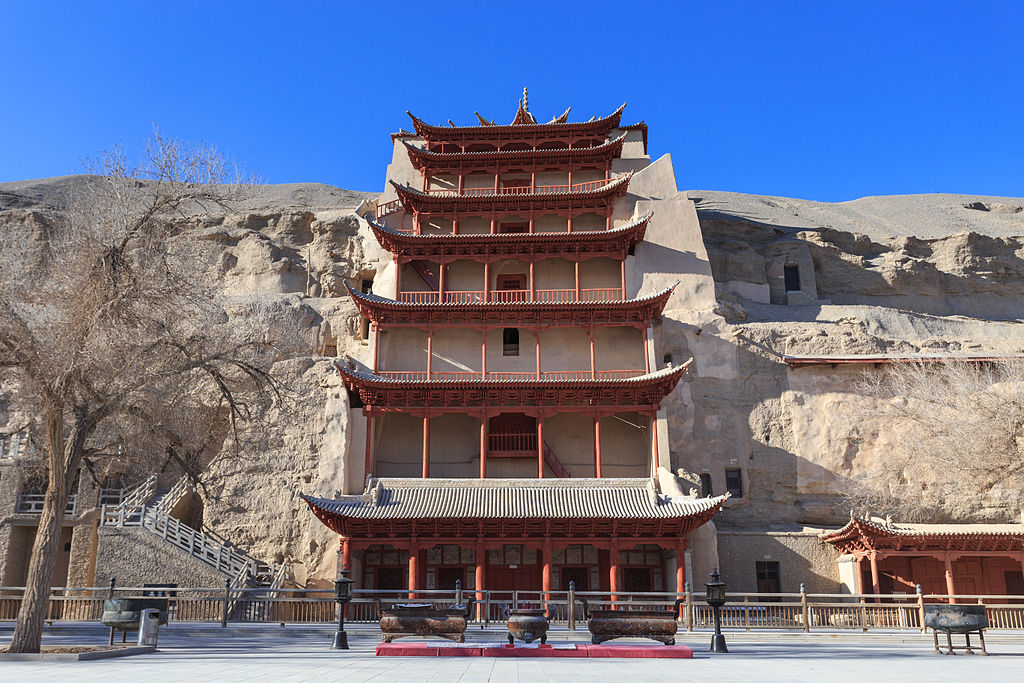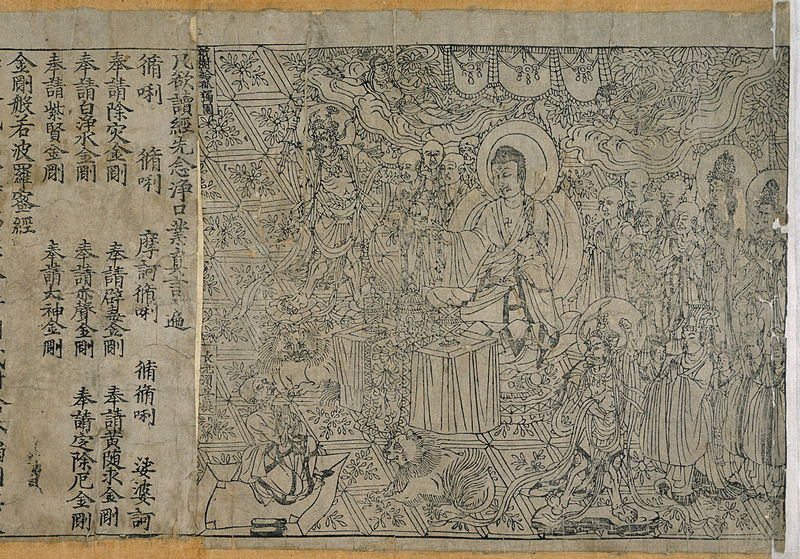|
China |
|
|
Dunhuang
Mogao Caves The Mogao Caves or Mogao Grottoes
(Chinese: 莫高窟; pinyin: Mògāo kū), also known as the Caves of the
Thousand Buddhas (Chinese: 千佛洞; pinyin: qiān fó dòng), form a system of
492 temples 25 km (16 mi) southeast of the center of Dunhuang, an oasis
strategically located at a religious and cultural crossroads on the Silk
Road, in Gansu province, China. The caves may also be known as the
Dunhuang Caves, however, this term is also used as a collective term to
include other Buddhist cave sites in the Dunhuang area, such as the
Western Thousand Buddha Caves, and the Yulin Caves farther away. The
caves contain some of the finest examples of Buddhist art spanning a
period of 1,000 years. The first caves were dug out in 366 CE as places
of Buddhist meditation and worship. The Mogao Caves are the best known
of the Chinese Buddhist grottoes and, along with Longmen Grottoes and
Yungang Grottoes, are one of the three famous ancient Buddhist
sculptural sites of China.
An important cache of documents was discovered in 1900 in the so-called "Library Cave," which had been walled-up in the 11th century. The content of the library was dispersed around the world, and the largest collections are now found in Beijing, London, Paris and Berlin, and the International Dunhuang Project exists to coordinate and collect scholarly work on the Dunhuang manuscripts and other material. The caves themselves are now a popular tourist destination, with a number open for visiting. History Dunhuang was established as a frontier
garrison outpost by the Han Dynasty Emperor Wudi to protect against the
Xiongnu in 111 BCE. It also became an important gateway to the West, a
centre of commerce along the Silk Road, as well as a meeting place of
various people and religions such as Buddhism.
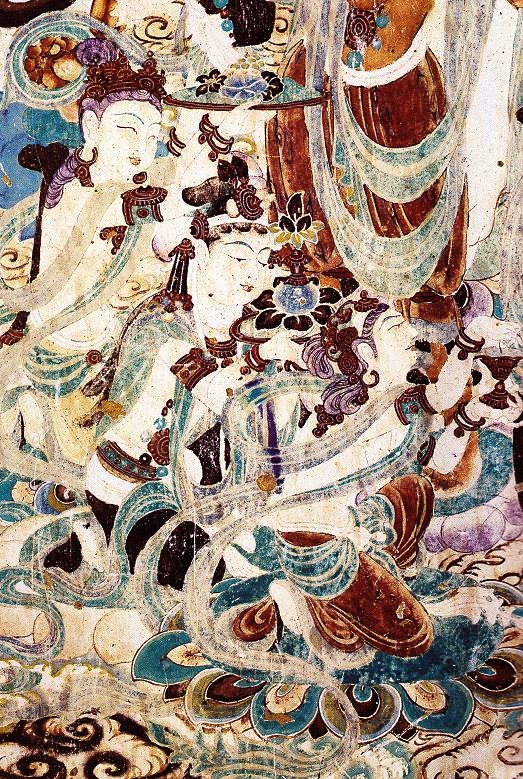 Details of painting of the meeting of Manjusri and Vimalakirti. Cave 159. The construction of the Mogao Caves near
Dunhuang is generally taken to have begun sometime in the fourth century
CE. According to a book written during the reign of Tang Empress Wu,
Fokan Ji (佛龕記, An Account of Buddhist Shrines) by Li Junxiu (李君修), a
Buddhist monk named Lè Zūn (樂尊, which may also be pronounced Yuezun) had
a vision of a thousand Buddhas bathed in golden light at the site in
366 CE, inspiring him to build a cave here. The story is also found in
other sources, such as in inscriptions on a stele in cave 332; an
earlier date of 353 CE however was given in another document, Shazhou
Tujing (沙州土鏡, Geography of Shazhou). He was later joined by a second
monk Faliang (法良), and the site gradually grew, by the time of the
Northern Liang a small community of monks had formed at the site.
Members of the ruling family of Northern Wei and Northern Zhou
constructed many caves here, and it flourished in the short-lived Sui
Dynasty. By the Tang Dynasty, the number of caves had reached over a
thousand.
The caves initially served only as a place of meditation for hermit monks, but developed to serve the monasteries that sprang up nearby in the early periods, and by the Sui and Tang dynasties, Mogao Caves had become a place of worship and pilgrimage for the public. From the 4th until the 14th century, caves were constructed by monks to serve as shrines with funds from donors. These caves were elaborately painted, the cave paintings and architecture serving as aids to meditation, as visual representations of the quest for enlightenment, as mnemonic devices, and as teaching tools to inform those illiterate about Buddhist beliefs and stories. The major caves were sponsored by patrons such as important clergy, local ruling elite, foreign dignitaries, as well as Chinese emperors. Other caves may have been funded by merchants, military officers, and other local people such as women's groups. During the Tang Dynasty, Dunhuang became the main hub of commerce of the Silk Road and a major religious centre. A large number of the caves were constructed at Mogao during this era, including the two large statues of Buddha at the site, the largest one constructed in 695 following an edict a year earlier by Tang Empress Wu Zetian to build giant statues across the country. The site escaped the persecution of Buddhists ordered by Emperor Wuzong in 845 as it was then under Tibetan control. As a frontier town, Dunhuang had been occupied at various times by other non-Han Chinese people. After the Tang Dynasty, the site went into a gradual decline, and construction of new caves ceased entirely after the Yuan Dynasty. By then Islam had conquered much of Central Asia, and the Silk Road declined in importance when trading via sea-routes began to dominate Chinese trade with the outside world. During the Ming Dynasty, the Silk Road was finally officially abandoned, and Dunhuang slowly became depopulated and largely forgotten by the outside world. Most of the Mogao caves were abandoned; the site, however, was still a place of pilgrimage and was used as a place of worship by local people at the beginning of the twentieth century when there was renewed interest in the site. Discovery and revival  Bodhisattva
Leading the Way, color on silk, 80.5 x 53.8 cm. The image was discovered
at Dun Huang in the "1000 Buddha cave" (cave 17). The bodhisattva is
leading a woman to the Pure Land on the golden cloud in the upper left
corner. His right hand contains an incense burner. His left hand
contains a lotus flower. Located at the British Museum Department of
Asia.
During late nineteenth century and early twentieth century, Western explorers began to show interest in the ancient Silk Road and the lost cities of Central Asia, and those who passed through Dunhuang noted the murals and artifacts such as the Stele of Sulaiman at Mogao. The biggest discovery, however, came from a Chinese Taoist named Wang Yuanlu who appointed himself guardian of some of these temples around the turn of the century. Some of the caves had by then been blocked by sand, and Wang set about clearing away the sand and made an attempt at repairing the site. In one such cave, on 25 June 1900, Wang discovered a walled up area behind one side of a corridor leading to a main cave. Behind the wall was a small cave stuffed with an enormous hoard of manuscripts. In the next few years, Wang took some manuscripts to show to various officials who expressed varying level of interest, but in 1904 Wang re-sealed the cave following an order by the governor of Gansu. Words of Wang's discovery drew the attention of a joint British/Indian group led by Hungarian archaeologist Aurel Stein who was on an archaeological expedition in the area in 1907. Stein negotiated with Wang to allow him to remove a significant number of manuscripts as well as the finest paintings and textiles for a fee. He was followed by a French expedition under Paul Pelliot who acquired many thousands of items in 1908, and then by a Japanese expedition under Otani Kozui in 1911 and a Russian expedition under Sergei F. Oldenburg in 1914. A well-known scholar Luo Zhenyu edited some of the manuscripts Pelliot acquired into a volume which was then published in 1909 as "Manuscripts of the Dunhuang Caves" (敦煌石室遺書). Stein and Pelliot provoked much interest in the West about the Dunhuang Caves; however, there was initially little interest in official circles in China. Concerned that the remaining manuscripts might be lost, Luo Zhenyu and others persuaded the Ministry of Education to recover the rest of the manuscripts to be sent to Peking (Beijing) in 1910. However, not all the remaining manuscripts were taken to Peking, and of those retrieved, some were then stolen. Some of the caves were damaged and vandalized by White Russian soldiers when they were used by the local authority in 1921 to house Russian soldiers fleeing the civil war following the Russian Revolution. In 1924, American explorer Langdon Warner removed a number of murals as well as a statue from some of the caves. In 1939 Kuomingtang soldiers stationed at Dunhuang caused some damage to the murals and statues at the site. The situation improved in 1941 when, following a visit by Wu Zuoren to the site the previous year, the painter Zhang Daqian arrived at the caves with a small team of assistants and stayed for two and a half years to repair and copy the murals. He exhibited and published the copies of the murals in 1943, which helped to publicize and give much prominence to the art of Dunhuang within China. Historian Xiang Da then persuaded Yu Youren, a prominent member of the Kuomintang (Chinese Nationalist Party), to set up an institution, the Research Institute of Dunhuang Art (which later became the Dunhuang Academy), at Mogao in 1944 to look after the site and its contents. In 1956, the first Premier of the People's Republic of China, Zhou Enlai, took a personal interest in the caves and sanctioned a grant to repair and protect the site; and in 1961, the Mogao Caves were declared to be a specially protected historical monument by the State Council, and large-scale renovation work at Mogao began soon afterwards. The site escaped the widespread damage caused to many religious sites during the Cultural Revolution. Today, the site is the subject of an ongoing archaeological project. The Mogao Caves became one of the UNESCO World Heritage Sites in 1987. From 1988 to 1995 a further 248 caves were discovered to the North of the 487 caves known since the early 1900s. The Library Cave The cave no. 17 discovered by Wang Yuanlu came to be known as the Library Cave. It is sited off the entrance leading to cave no.16, and was originally used as a memorial cave for a local monk Hongbian on his death in 862 CE. Hongbian, from a wealthy Wu family, was responsible for the construction of cave 16, and the Library Cave may have been used as his retreat in his lifetime. The cave originally contained his statue which was moved to another cave when it was used to keep manuscripts, some of which bear Hongbian's seal. Large number of documents dating from 406 to 1002 CE were found in the cave, heaped up in closely packed layers of bundles of scrolls. In addition to the 1,100 of bundles of scrolls, there were also over 15,000 paper books. The Library Cave also contained textiles such as banners, numerous damaged figurines of Buddhas, and other Buddhist paraphernalia. According to Stein who was the first to describe the cave in its original state: Heaped up in layers, but without any order, there appeared in the dim light of the priest's little lamp a solid mass of manuscript bundles rising to a height of nearly ten feet, and filling, as subsequent measurement showed, close on 500 cubic feet. The area left clear within the room was just sufficient for two people to stand in. 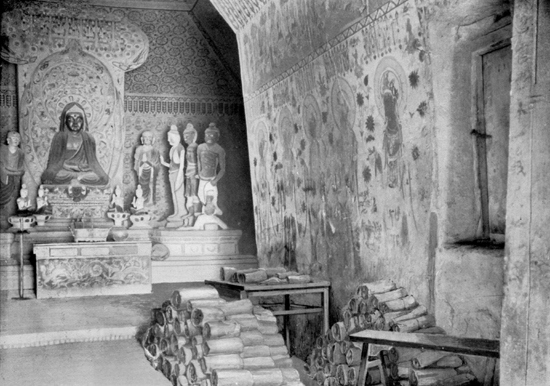 Picture of Cave 16, by Aurel Stein in 1907, with manuscripts piled up beside the entrance to Cave 17, the Library Cave. Aurel Stein - Early Tibet Blog, Secrets of the Cave II: The “Library Cave” (earlytibet.com) The Library Cave was walled off sometime early in the 11th century. A number of theories have been proposed as the reason for sealing the caves. Stein first proposed that the cave had become a waste repository for venerable, damaged and used manuscripts and hallowed paraphernalia and then sealed perhaps when the place came under threat. Following this interpretation some suggested that the handwritten manuscripts of the Tripitaka became obsolete when printing became widespread, the older manuscripts were therefore stored away. Another suggestion is that the cave was simply used as a book storehouse for documents which accumulated over a century and a half, then sealed up when it became full. Others, such as Pelliot, suggested an alternative scenario, that the monks hurriedly hid the documents in advance of an attack by invaders, perhaps when Xi Xia invaded in 1035. This theory was proposed in light of the absence of documents from Xi Xia and the disordered state in which Pelliot found the room (perhaps a misinterpretation because unbeknownst to him the room was disturbed by Stein months before). Another theory posits that the items were from a monastic library and hidden due to threats from Muslims who were moving eastward. This theory proposes that that the monks of a nearby monastery heard about the fall of the Buddhist kingdom of Khotan to Karakhanids invaders from Kashgar in 1006 and the destruction it caused, so they sealed their library to avoid it being destroyed. The latest date recorded in the documents found in the cave is generally accepted to be 1002, and although other dates have been suggested, the cave was likely to have been sealed not long after that date. |
|
Dunhuang manuscripts
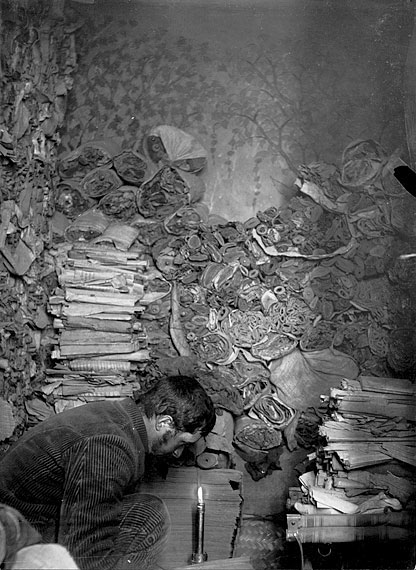 Paul Pelliot examining manuscripts in the Library Cave, 1908 Charles Nouette (1869-1910) - Musée Guimet, archives photographiques, AP8186 The manuscripts from the Library Cave date from fifth century until early eleventh century when it was sealed. Up to 50,000 manuscripts may have been kept there, one of the greatest treasure troves of ancient documents found. While most of them are in Chinese, a large number of documents are in various other languages such as Tibetan, Uigur, Sanskrit, and Sogdian, including the then little-known Khotanese. They may be old hemp paper scrolls in Chinese and many other languages, Tibetan pothis, and paintings on hemp, silk or paper. The subject matter of the great majority of the scrolls is Buddhist in nature, but it also covers a diverse material. Along with the expected Buddhist canonical works are original commentaries, apocryphal works, workbooks, books of prayers, Confucian works, Taoist works, Nestorian Christian works, works from the Chinese government, administrative documents, anthologies, glossaries, dictionaries, and calligraphic exercises. Many of the manuscripts were previously unknown or thought lost, and the manuscripts provide a unique insight into the religious and secular matters of Northern China as well as other Central Asian kingdoms from the early periods up to the Tang and early Song Dynasty. The manuscripts found in the Library Cave include the earliest dated printed book, the Diamond Sutra from 868 CE, which was first translated from Sanskrit into Chinese in the fourth century. These scrolls also include manuscripts that ranged from the Nestorian Jesus Sutras to the Dunhuang Go Manual and ancient music scores, as well as the image of the Chinese astronomy Dunhuang map. These scrolls chronicle the development of Buddhism in China, record the political and cultural life of the time, and provide documentation of mundane secular matters that gives a rare glimpse into the lives of ordinary people of these eras. The manuscripts were dispersed all over the world in the aftermath of the discovery. Stein's acquisition was split between Britain and India because his expedition was funded by both countries. Stein had the first pick and he was able to collect around 7,000 complete manuscripts and 6,000 fragments for which he paid £130, although these include many duplicate copies of the Diamond and Lotus Sutras. Pelliot took almost 10,000 documents for the equivalent of £90, but, unlike Stein, Pelliot was a trained sinologist literate in Chinese, and he was allowed to examine the manuscripts freely, so he was able to pick a better selection of documents than Stein. Pelliot was interested in the more unusual and exotic of the Dunhuang manuscripts, such as those dealing with the administration and financing of the monastery and associated lay men's groups. Many of these manuscripts survived only because they formed a type of palimpsest whereby papers were reused and Buddhist texts were written on the opposite side of the paper. Hundreds more of the manuscripts were sold by Wang to Otani Kozui and Sergei Oldenburg. Efforts are now underway to reconstitute the Library Cave manuscripts digitally, and they are now available as part of International Dunhuang Project. Art The art of Dunhuang covers more than ten major genres, such as architecture, stucco sculpture, wall paintings, silk paintings, calligraphy, woodblock printing, embroidery, literature, music and dance, and popular entertainment.  Mural of Avalokiteśvara (Guanyin), Worshipping Bodhisattvas and Mendicant in cave 57. Figures originally adorned with gold leaf. Early Tang. Architecture The caves are examples of rock-cut architecture, but unlike Longmen Grottoes and Yungang Grottoes, the local rock is a rather softgravel conglomerate that is not suitable for either sculpture or elaborate architectural details. Many of the early caves were developed from earlier Buddhist rock-cut chaitya styles seen in places such as the Ajanta Caves in India, with a square-sectioned central column, with sculpture in niches, representing the stupa round which worshippers may circumambulate (parikrama) and gain blessings. Others are hall caves influenced by traditional Chinese and Buddhist temple architecture. These caves may have a truncated pyramidal ceiling sometimes painted to resemble a tent, or they may have a flat or gabled ceiling that imitates traditional buildings. Some of the caves used for meditation are adaptations of the Indian vihara (monastery) cave plan and contain side-chambers just large enough for one person to sit in. 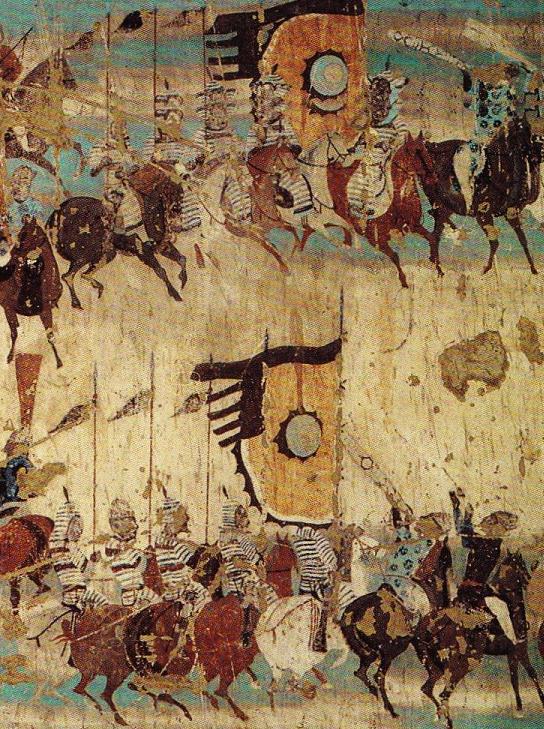 Detail of mural commemorating victory of General Zhang Yichao over the Tibetans. Dunhuang Mogao cave 156, Late Tang Dynasty. Source Dunhuang Mogao Caves, scanned from Cave Temples of Dunhuang: Art and History on the Silk Road. Many of the caves originally had
wooden porches or fore-temples built out from the cliff, but most of
these have decayed or been lost in other ways, with only five remaining,
the two earliest of which are rare surviving examples of Song dynasty
wooden architecture. The most prominent wooden building at the site,
first built during the Tang dynasty, housed a large Buddha and was
originally 4 storeys high, but it has been repaired at least 5 times and
is no longer the original structure. A storey was added between
874-885, then repaired in theGuiyijun period, and two further storeys
were added during a restoration in 1898. Two further restorations were
carried out in the 20th century, and the building is now a 9-storey
structure.
Murals The most fully painted caves have paintings all over the walls and ceilings, with geometrical or plant decoration filling the spaces not taken by figurative images, which are above all of the Buddha. Sculpture is also brightly painted. The murals on the caves date from a period of over a thousand years, from the 5th to the 14th century; many were repainted at later points within the period. The murals are extensive, covering an area of 490,000 square feet (45,000 m²). They are valued for the scale and richness of content as well as their artistry. Buddhist subjects are most common, however some have traditional mythical subjects and portraits of patrons. These murals document the changing styles of Buddhist art in China for nearly a thousand years. The artistry of the murals reached its apogee during the Tang period, and the quality of the work dropped after the tenth century.  Early mural
revealed after later over-painting had been partly removed. The flesh
tones of the figure with its pigments protected from oxidation contrast
with the darkened tone of buddhas in later painting seen on the right.
Cave 253, Northern Wei.Mural from Mogao cave 263, showing underlying
painting. Northern Wei Dynasty. Later painting seen on right hand side. Source
Dunhuang Mogao Caves, scanned from Whitfield, Roderick, Susan Whitfield,
and Neville Agnew. "Cave Temples of Dunhuang: Art and History on the
Silk Road"
A common motif in many caves is the areas entirely covered by rows of small seated Buddha figures, after which this and other "Thousand Buddhas Caves" are named. These small Buddhas were drawn using stencils so that identical figures may be replicated. Flying apsaras, or celestial beings may be depicted in the ceiling or above the Buddhas, and figures of donors may be shown along the bottom of the walls. The paintings often depict jataka tales which are stories of the life of Buddha, or avadana which are parables of the doctrine of karma. Bodhisattvas started appearing during the Northern Zhou period, with Avalokitesvara (Guanyin), which was originally male but acquired female characteristics later, the most popular. Most caves show Mahayana and Sravakayana (Theravada or Hinayana) influences, although Mahayana Buddhism became the dominant form during the Sui Dynasty. An innovation of the Sui-Tang period is the visual representation of the sutra - Mahayana Buddhist teachings transformed into large complete and detailed narrative paintings. One of the central features of Tang art in Mogao is the representation of the paradise of the Pure Land, indicating the increasing popularity of this school of Mahayana Buddhism in the Tang era. The iconography of Tantric Buddhism, such as the eleven-headed or thousand-armed Avalokitesvara, also started to appear in Mogao wall paintings during the Tang period – it became popular during the Tibetan occupation of Dunhuang and the subsequent periods, especially during the Yuan dynasty.  Figures
showing shading technique, and on the left, the effect of darkening of
the paint used in shading which changed the appearance of the figure.
Murals details from Dunhuang showing shading techique. Figure on left
from cave 275 from the Northern Liang period (397–460), figure on right
from cave 428 from the Northern Zhou dynasty (557 - 581)..
While Buddhist art is stylistically distinct from secular art, the style of paintings in the caves often reflects that of contemporary secular painting (insofar as we know of this), especially those depicting secular scenes. Donor figures are generally depicted in secular style, and may include secular events associated with them. For example, scenes depicting General Zhang Yichao, who ruled over Dunhuang in a quasi-autonomous manner during the Late Tang period, include a commemoration of his victory over the Tibetans in 848. The portraits of donors increased in size during the period ruled by the Cao family who succeeded the Zhang family. The Caos formed alliances with the Uyghurs (Uyghur Gansu Kingdom and Kingdom of Qocho) and the SakaKingdom of Khotan and their portraits are featured prominently in some of the caves. Many of the figures have darkened due to oxidation of the lead-based pigments from exposure to air and light. Many early figures in the murals in Dunhuang also used painting techniques originated from India where shading was applied to achieve a 3-dimensional or chiaroscuroeffect. However, the darkening of the paint used in shading over time resulted in heavy outlines which is not what the painters had originally intended. This shading technique is unique to Dunhuang in East Asia at this period as such shading on human faces was generally not done in Chinese paintings until much later when there were influences from European paintings. Another difference from traditional Chinese painting is the presence of figures that are semi-nude, occasionally fully nude, as figures are generally fully clothed in Chinese paintings. Many of the murals have been repaired or plastered over and repainted over the centuries, and older murals may be seen where sections of later paintings had been removed. |
|
Sculptures The Great Buddha of cave 96 Great Buddha of Mogao Caves, largest Buddha figure at 35.5 m tall, Cave 96. Constructed under the edicts of Empress Wu Zetian in 695 CE. by David Tansey There are around 2,400 surviving clay sculptures at Mogao. These were first constructed on a wooden frame, padded with reed, then modelled in clay stucco, and finished with paint. The giant statues however have a stone core. The Buddha is generally shown as the central statue, often attended by boddhisattvas, heavenly kings, devas, and apsaras, along with yaksas and other mythical creatures. Figure of Maitreya Buddha in cave 275 from Northern Liang (397-439), one of the earliest caves.
The crossed ankle figure with a three-disk crown shows influence fromKushan art. by Bairuilong The early figures are relatively simple and mainly of Buddhas and Bodhisattvas. The Buddhas of Northern Wei may have two attendant Bodhisattvas, and two further disciples were added in Northern Zhou, forming a group of five. Figures from the Sui and Tang periods may be present as larger groups of seven or nine, and some showed large-scaleparinirvana scene with groups of mourners. The early sculptures were based on Indian and Central Asian prototypes, with some in the Greco-Indian style of Gandhara. Over time the sculptures showed more Chinese elements and became gradually sinicized. The two giant statues represent Maitreya Buddha. The earlier and larger one in cave 96, at 35.5 m high, was constructed in 695 CE under the edicts from Empress Wu Zetian who instructed the constructions of monasteries in 689 and giant statues in 694. The smaller one is 27 m tall and was constructed in 713-41 CE. The larger northern giant Buddha was damaged in an earthquake and had been repaired and restored multiple times, consequently its clothing, colour and gestures had been changed and only the head retains its original Early Tang appearance. The southern statue however is largely in its original form apart for its right hand. The larger Buddha is housed in a prominent wooden 9-storey structure.  Reproduction
of the reclining Buddha of the Tibetan period from cave 158. National
Art Museum of China, Beijing. Display of reproduction of artworks from
the Mogao Caves in Dunhuang in the National Art Museum of China,
Beijing. The original is in Cave 158 of Mogao Caves, dating from the
Tibetan period. by gongfu_king
One type of caves constructed during the Tibetan era is the Nirvana Cave, which features a large reclining Buddha that covers the entire length of the hall. The Buddha figure in cave 158 measures 15.6 m long. The original function of the "Library Cave" was as a shrine commemorating Hong Bian, the 9th-century monk. His portrait statue, unusual here and among all surviving works in China, was removed to another spot when the cave was sealed up in the 11th century, but has been returned now the library has been removed. There is also a stone stele describing his life, and the wall behind the statue is painted with attendant figure; such blending of painted sculpture and wall paintings into a single composition is very common at the site. Paintings on silk and paper Before the discovery in the Library Cave, original paintings from the Tang dynasty, a formative period in Chinese art, were very rare, and most of the surviving evidence was from copies made in later periods. Over a thousand paintings on silk, banners, and embroideries were found in the Library Cave, none apparently dating before the late 7th century. The great majority of the paintings are anonymous, but many are of high quality, especially from the Tang. Most are sutra paintings, images of Buddha, and narrative paintings. The paintings show something of the contemporary Chinese style of the capital Chang'an, but many also reflect Indian, Tibetan and Uighur painting styles. There are brush paintings in ink alone, some in just two colours, as well as many in full colour. Most common are single figures, and most paintings were probably donated by an individual, who is often portrayed on a diminutive scale. The donor figures become notably more elaborate in dress by the 10th century. Printed images The Chinese Diamond Sūtra, the oldest known dated printed book in the world, British Library Or.8210/P.2. he colophon, at the inner end, reads: Reverently [caused to be] made for universal free distribution by Wang Jie on behalf of his two parents on the 13th of the 4th moon of the 9th year of Xiantong [i.e. 11th May, CE 868 ]. - Zoomable image from the British Library's Online Gallery. Originally uploaded to en:Wikipedia (log) in January 2008 by Fconaway (talk) and in November 2009 by Earthsound. Frontispiece, Diamond Sutra from Cave 17, Dunhuang, ink on paper. A page from the Diamond Sutra, printed in the 9th year of Xiantong Era of the Tang Dynasty, i.e. 868 CE. Currently located in the British Library, London. According to the British Library, it is “the earliest complete survival of a dated printed book”. The Library Cave is equally important as a source of rare early images and texts produced by woodblock printing, including the famous Diamond Sutra, the earliest printed book to survive. Other printed images were made to be hung, often with text below containing prayers and sometimes a dedication by the pious commissioner; at least two prints were commissioned by Cao Yuanzhong, Imperial Commissioner at Dunhuang in 947. Many of the images have colour added by hand to the printed outline. Several sheets contain repeated impressions of the same block with a Buddha image. Possibly these reflect stock for cutting when sold to pilgrims, but inscriptions in some examples show these were also printed out at different times by an individual as a devotion to acquire merit. It is unclear whether such people owned their own blocks, or visited a monastery to have the images printed. Textiles 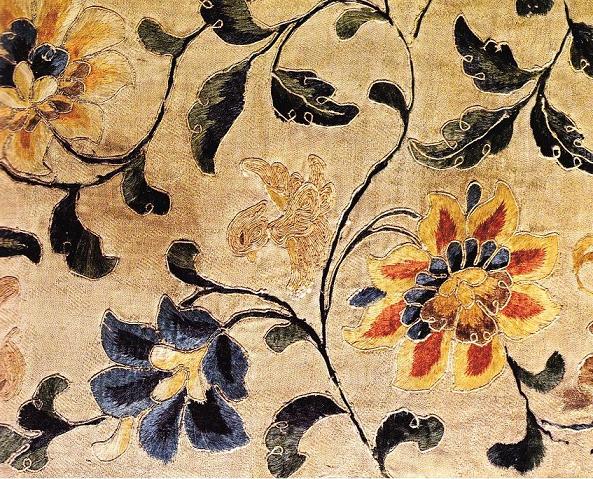 The textiles found in the Library Cave include silk banners, altar hangings, wrappings for manuscripts, and monks' apparel (kāṣāya). The monks normally used fabrics consisting of a patchwork of different scraps of cloth as a sign of humility; these therefore provide valuable insights into the various type of silk cloth and embroidery available at the time. Silk banners were used to adorn the cliff-face at the caves during festivals, and these are painted and may be embroidered. Valances used to decorate altars and temples had a horizontal strip at the top, from which hung streamers made from strips of different cloths ending in a V that look like a modern male necktie. Caves 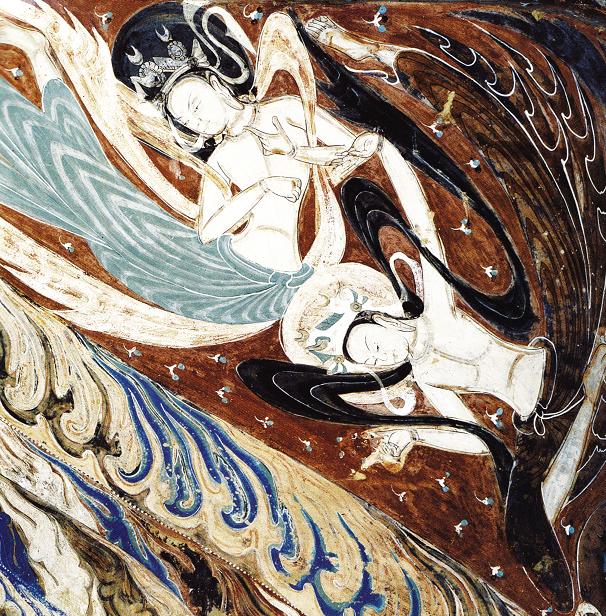 Flying apsaras, or celestial beings. Caves 285, 538-539 AD, Western Wei Dynasty
The caves were cut into the side of a cliff which is close to two kilometers long. At its height, during the Tang Dynasty, there were more than a thousands caves, but over time many of the caves were lost, including the earliest caves. 735 caves currently exist in Mogao; the best-known ones are the 487 caves located in the southern section of the cliff which are places of pilgrimage and worship. 248 caves have also been found to the north which were living quarters, meditation chambers, and burial sites for the monks. The caves at the southern section are decorated, while those at the northern section are mostly plain. The caves are clustered together according to their era, with new caves from a new dynasty being constructed in different part of the cliff. From the murals, sculptures, and other objects found in the caves, the dates of around five hundred caves have been determined. Following is a list of the caves by era, compiled in the 1980s (more have been identified since):
|
|
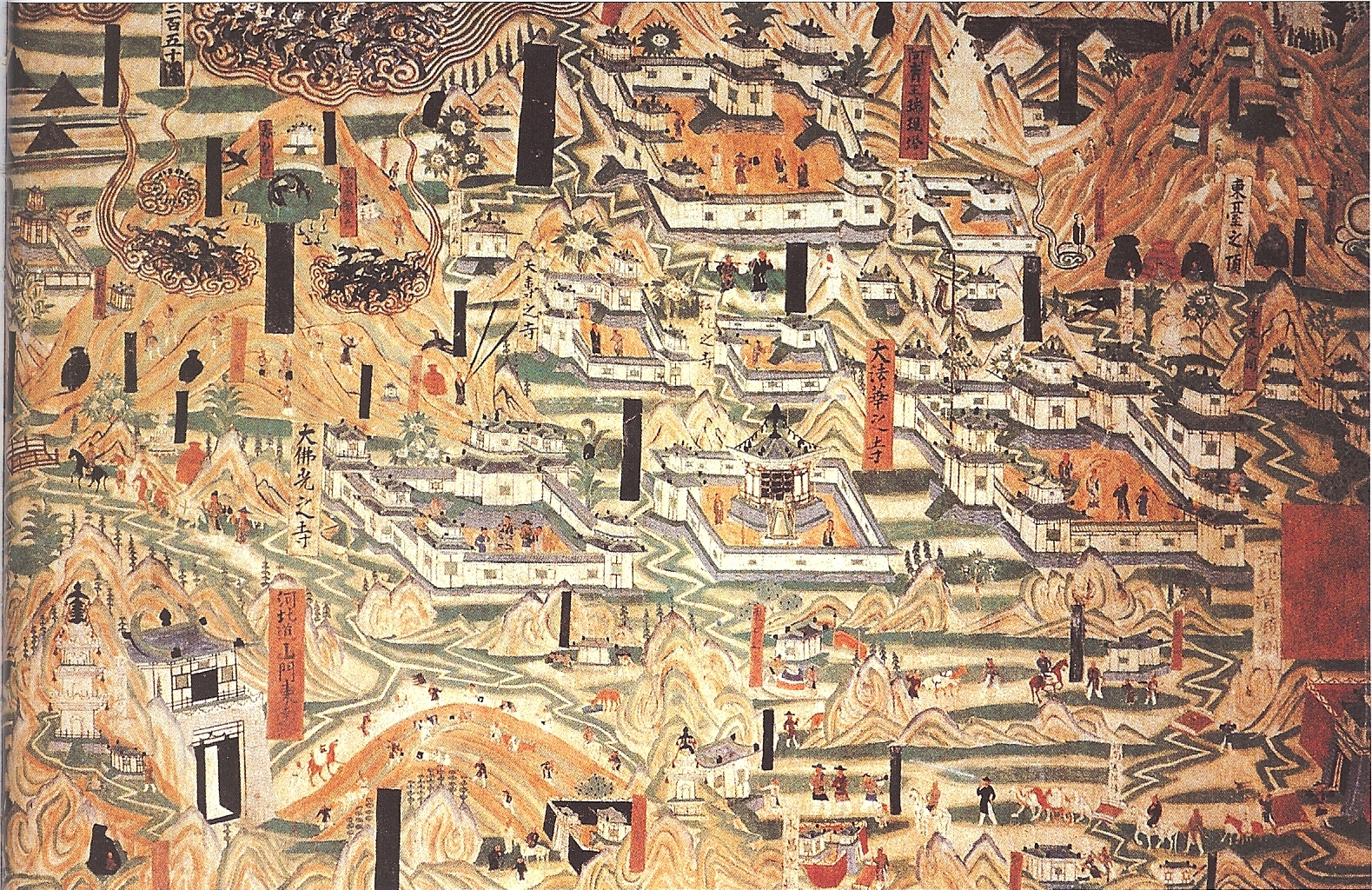 10th century mural from Cave 61, showing Tang Buddhist monasteries ofMount Wutai, Shanxiprovince Chinese artist(s) from the 10th century - Scanned from Patricia Ebrey's Cambridge Illustrated History of China (1999)  Vaishravana riding across the waters. Five Dynasties, mid-10th century CE.  The travel of Zhang Qian to the West. Mogao caves, 618-712 CE. "This is a section of a Dunhuang mural showing a line of officials led by Han Emperor Wu (Han Wudi) to see off Zhang Qian in the outskirts of Chang'an (the capital city). Zhang Qian is shown kneeling at the left edge of the painting."  In this close-up detail of a landscape painting, the young Sakyamuni cuts off his hair while attendants watch, ink and color on silk, from Dunhuang, Gansu province, China, dated to the Tang Dynasty (618–907 AD) Tang Dynasty (618–907 AD) Source Scanned from Michael Sullivan's The Arts of China: Fourth Edition (1999)   Vajrapani Painting at Mogao Caves (Library Cave) |
|
|
Diamond Sutra
 Frontispiece of the Chinese Diamond Sūtra, the oldest known dated printed book in the world The Diamond Sūtra
(Sanskrit:Vajracchedikā Prajñāpāramitā Sūtra) is a Mahāyāna (Buddhist)
sūtra from the Prajñāpāramitā, or "Perfection of Wisdom" genre, and
emphasizes the practice of non-abiding and non-attachment. The Diamond
sutra is one of the most influential Mahayana sutras in East Asia, and
is a key object of devotion and study in Zen Buddhism.
A copy of the Chinese version of Diamond Sūtra, found among the Dunhuang manuscripts in the early 20th century by Aurel Stein, was dated back to May 11, 868. It is, in the words of the British Library, "the earliest complete survival of a dated printed book." Diamond Sutra - Wikipedia |
|
|
Lotus Sutra
 Lotus Sutra Mandala, Honpoji, Toyama, Japan, c. 1326-28  A Goryeo-illustrated manuscript of the Lotus Sutra, c.1340 Lotus Sutra - Wikipedia |
|
|
Detail of
the Star Map from the Tang Dynasty showing the North Polar region
(British Library Or.8210/S.3326). This map was made around the year
700,[1] around the reign of Emperor Zhongzong of Tang (705-710).
Constellations of the three schools were distinguished with different
colors: white, black and yellow for stars of Wu Xian, Gan De and Shi
Shen respectively. The whole set of star maps contained 1,300 stars
The
Dunhuang map or Dunhuang Star map is one of the first known graphical
representations of stars from ancient Chinese astronomy, dated to the
Tang Dynasty (618–907). Before this map, much of the star information
mentioned in historical Chinese texts had been questioned. The map
provides a graphical verification of the star observations, and are part
of a series of pictures on one of the Dunhuang manuscripts. The
astronomy behind the map is explained in an educational resource posted
on the website of the International Dunhuang Project, where much of the
research on the map has been done. The Dunhuang Star map is to date the
world's oldest complete preserved star atlas.
History Early in 1900s (decade), a walled-up cave containing a cache of manuscripts was discovered by Chinese Taoist Wang Yuan-lu in the Mogao Caves. The scroll with the star chart was found amongst those documents by Aurel Stein when he visited and examined the content of the cave in 1907. One of the first public mentionings of this script in Western studies was from Joseph Needham's 1959 version of the book Science and Civilisation in China. Since that time, only a few publications have been devoted to the map, nearly all being Chinese publications. Dunhuang Star Chart - Wikipedia |
|
Dunhuang Cave Art Harvard Museum Kneeling Attendant Bodhisattva (from Mogao Cave 328, Dunhuang, Gansu province) - Harvard Museum  Three Figures (from the north side of the east wall of Mogao Cave 323, Dunhuang, Gansu province) - Harvard Museum  Kneeling Attendant Holding a Triple Jewel (from the north wall of Mogao Cave 329, Dunhuang, Gansu province) - Harvard Museum  Eight Men Ferrying a Statue of the Buddha (from Mogao Cave 323, Dunhuang, Gansu province) - Harvard Museum  Bust of Bodhisattva (from the north wall of Mogao Cave 329 at Dunhuang, Gansu province) - Harvard Museum  Bust of an Attendant Bodhisattva (from the south wall of Mogao Cave 320, Dunhuang, Gansu province) - Harvard Museum  Bust of a Bodhisattva Surrounded by a Monk and Devas (from the south wall of Mogao Cave 320, Dunhuang, Gansu province) - Harvard Museum  Head and Shoulders of Buddhist Figure (from the north wall of Mogao Cave 321 at Dunhuang, Gansu province) - Harvard Museum  Three Adoring Figures (from the south wall of Mogao Cave 335 at Dunhuang, Gansu province) - Harvard Museum  Three Kneeling Adoring Bodhisattva (from the south wall of Mogao Cave 335 at Dunhuang, Gansu province) - Harvard Museum  Busts of Bodhisattvas (from Mogao Cave 321, Dunhuang, Gansu province) - Harvard Museum  Bodhisattva with Attendants and Donor (a forgery purporting to date to the Tang dynasty, from Dunhuang, Gansu province) - Harvard Museum |
|
References
Further reading
|
|
Gallery |
|
| FAIR USE NOTICE: This page contains copyrighted material the use of which has not been specifically authorized by the copyright owner. Pegasus Research Consortium distributes this material without profit to those who have expressed a prior interest in receiving the included information for research and educational purposes. We believe this constitutes a fair use of any such copyrighted material as provided for in 17 U.S.C § 107. If you wish to use copyrighted material from this site for purposes of your own that go beyond fair use, you must obtain permission from the copyright owner. | |
|
|
